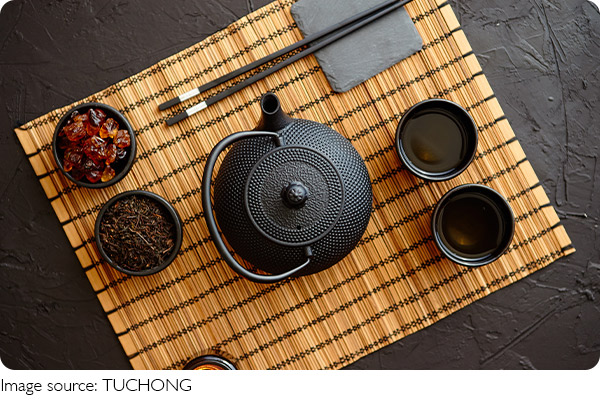Tea Art

Have you ever stepped into a space where every movement feels deliberate, every item carefully chosen, and every sip tells a story? This is exactly what the Japanese tea ceremony, or sadou, offers.
Far beyond simply drinking tea, it’s a cultural ritual that blends art, history, and mindfulness. By learning and experiencing this tradition, we not only enjoy delicious matcha but also gain a glimpse into Japanese culture, etiquette, and lifestyle.
The Tea Ceremony as a Cultural Art
The Japanese tea ceremony is often called a comprehensive cultural art, and it truly deserves the title. Everything, from the tools used for making tea to the arrangement of the tea room, is designed for harmony and elegance. Tea rooms feature carefully selected calligraphy, seasonal flowers, and decorations that show respect for aesthetics and the moment. Some utensils are highly valued because of their history or the skill of the craftsman who made them.
Tea culture is so valued that many Japanese schools have tea clubs, especially popular among young women. In Kyoto, learning tea ceremonies is nearly a cultural rite of passage. Every October, Japan holds a Tea Culture Certification Exam with levels from 1 to 4, showing how deeply ingrained this practice is in modern society.
The Tea Room: A Place of Calm
The ceremony takes place in a chashitsu, or tea room, typically about four and a half tatami mats in size. These rooms are designed with alcoves, hearths, and a small prep area called a mizuya, where utensils and hot water are prepared. Windows are made of rice paper, and walls often display seasonal calligraphy and flower arrangements, each element chosen for balance and elegance.
Being in a tea room is itself a calming experience. Every detail, from the layout to the smallest decoration, reflects mindfulness and care.

Etiquette Before Drinking
Before participating, there are some essential rules. We should remove watches and metal jewelry, as the items used in the ceremony are valuable. Women should avoid short skirts, and men are recommended to wear white socks because seating is formal. Strong perfume should also be avoided, as matcha has a delicate fragrance that can be easily overpowered.
In the tea ceremony, the host is called teishu, the main guest is shokyaku, and other guests are renkyaku. The host serves tea to the main guest first, followed by the accompanying guests, creating a mindful, respectful environment.
Wagashi and Matcha
Traditionally, tea was considered medicinal, so it was consumed moderately. To protect the stomach, small sweets called wagashi are served before drinking. These Japanese sweets balance the slightly bitter taste of matcha perfectly. We are expected to finish the sweets before drinking, allowing us to fully enjoy both flavors and the ritual itself.
Making Tea: Step by Step
The host begins by placing powdered matcha into a tea bowl—thin tea uses about 2 grams, and thick tea about 4 grams. Hot water, around 80°C, is poured in using a bamboo ladle called hishaku. Next, the tea is whisked using a bamboo whisk called chasen until smooth, taking roughly one minute. This process, called temae, is performed with deliberate, graceful movements.
Serving and Drinking Tea
Once prepared, the host presents the tea bowl to the main guest, rotating it to show its decoration. Guests follow a mindful sequence: rotate the bowl clockwise to avoid drinking from the front design, hold it with both hands, sip slowly, and focus on the tea without distraction. After drinking, the bowl is rotated back toward the host before conversation begins.
For thin tea, we typically finish the bowl and wipe the rim with our thumb and forefinger. For thick tea, finishing is optional, but if completed, the rim is wiped in the same careful manner. These small gestures reflect mindfulness, respect, and cultural awareness.
Why We Should Experience Tea Ceremony
Learning and participating in a Japanese tea ceremony offers more than just a taste of matcha. It cultivates patience, mindfulness, respect for tradition, and social etiquette. By experiencing this ritual, we can slow down in a fast-paced world, connect with Japanese history, and enjoy a moment of calm and elegance.
Lykkers, if you ever visit Japan, joining a tea ceremony is not just a cultural experience—it’s a peaceful escape that engages all our senses and leaves a lasting impression.
-
 Master Cruise ControlLearn simple habits to use cruise control safely and stress-free.
Master Cruise ControlLearn simple habits to use cruise control safely and stress-free. -
 Skiing Safe and SmartMost ski injuries are preventable — here’s how to stay safe on the slopes this winter
Skiing Safe and SmartMost ski injuries are preventable — here’s how to stay safe on the slopes this winter -
 Amblyopia: Must Know!Could Vision Be Weak In One Eye? Learn How Amblyopia Shows And How To Protect Sight Fast!
Amblyopia: Must Know!Could Vision Be Weak In One Eye? Learn How Amblyopia Shows And How To Protect Sight Fast!